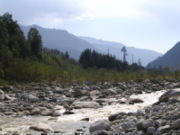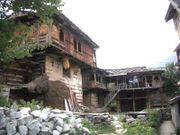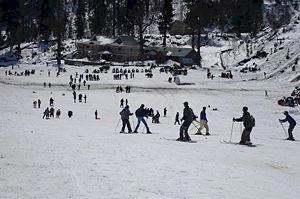Himachal Pradesh : Manali
 Manali,
(alt. 1,950 m or 6,398 ft) on the Beas River valley, is an important
hill station in the Himalayan mountains of Himachal Pradesh, India,
near the northern end of the Kullu Valley. It is administratively a
part of the Kullu District. The population is approx. 30,000. There
are actually two parts of Manali. Aleo New-Manali town is on the banks
of the Beas river and the Old Manali village lies east of the Manalsu
nullah, which in its present form, is more of a hippy enclave. Manali,
(alt. 1,950 m or 6,398 ft) on the Beas River valley, is an important
hill station in the Himalayan mountains of Himachal Pradesh, India,
near the northern end of the Kullu Valley. It is administratively a
part of the Kullu District. The population is approx. 30,000. There
are actually two parts of Manali. Aleo New-Manali town is on the banks
of the Beas river and the Old Manali village lies east of the Manalsu
nullah, which in its present form, is more of a hippy enclave.
The small town was the beginning of an ancient trade route to Ladakh
and, from there, over the Karakoram Pass on to Yarkand and Khotan in
the Tarim Basin.
Manali is a popular Himalayan tourist destination and accounts for
nearly a quarter of all tourist arrivals in Himachal Pradesh. It is
visited by many trekkers who follow the hashish trail. Manali's charas
is considered to be the best in India. The valleys provide natural U.V
lights as fields are high up the mountain and high grade grows
directly from the sunlight.ala. Manali's cool atmosphere provides a
perfect haven for the ones afflicted by the hot Indian summers. It is
famous for adventure sports like skiing, hiking, mountaineering, para
gliding, rafting, trekking, kayaking, and mountain biking. It also
offers hot springs, spectacular religious shrines and temples, Tibetan
Buddhist temples, and trekking in the surrounding mountains.

Naggar Fort south of Manali is a reminder of the 1500 year old Pal
Dynasty. Made from rocks, stones, and elaborate wood carvings, it is
an ensemble of the rich and elegant artworks of Himachal. The castle
was later converted to a rest house and luxury hotel. Tourists often
stop at the castle to see the small shrine located in the building's
courtyard, a fine example of architecture and design from the Pal
Dynasty.
The often visited site in Manali is the Dhungri or Hadimba Temple.
Erected in 1533, this temple is dedicated to the local deity Hadimba,
wife of the Pandava prince, Bhim. A major festival is held here in the
month of May. The temple is noted for its four-storeyed pagoda and
exquisite wooden carvings.
Manali is known for its shiny gompas or Buddhist monasteries. With the
highest concentration of Tibetan refugees in the entire Kullu valley,
it is famous for its Gadhan Thekchhokling Gompa, built in 1969. The
monastery is maintained by donations from the local community and
through the sale of hand-woven carpets in the temple workshop.
The smaller and more modern Himalayan Nyingamapa Gompa stands nearer
the bazaar, in a garden blooming with sunflowers. Its main shrine, lit
by dozens of electric bulbs and fragrant with Tibetan incense, houses
a colossal gold-faced Buddha, best viewed from the small room on the
first floor.
The Museum of Traditional Himachal Culture, near the Hadimba temple,
is worth a visit, which houses artifacts of folk art of the entire
Kullu valley.
 Skiing
is a major pastime in Manali. Facilities for skiing are available at
Solang Nullah (January-March) and Rohtang La (during summer). The
Mountaineering Institute at Solang Nullah is a good training
institute. Heli skiing is possible at the deep snowfields. Skiing
is a major pastime in Manali. Facilities for skiing are available at
Solang Nullah (January-March) and Rohtang La (during summer). The
Mountaineering Institute at Solang Nullah is a good training
institute. Heli skiing is possible at the deep snowfields.
Skiing at SolangThe Mountaineering Institute and Allied Sports is
about 3 km from the Mall and offers mountaineering and kayaking
courses. Kayaking is possible on the Beas River.
There are several good hikes from Manali. The 12 km hike up the
western banks of the Beas to the Solang Valley is noteworthy. Lama
Dugh meadow is a 6 km hike up to the Manalsu Nala, west of Manali
town.
For the best trekking expedition, take a trek from Solang Valley, on
to Dhundhi and from there to Dussar lake and then onwards to Manali.
This stretch will take you to places you would have only dreamt of.
Pure, unadulterated adventure and fun. Be sure to have a good guide at
your disposal who knows this area otherwise you would be lost forever.
The trek would typically last for 5 days.
In the summers, several travel agencies organize paragliding on the
slopes of the Solang Nullah. The charges generally include
accommodation, food, equipment, and a guide, but not transport.
From May to July and, depending on the monsoons, from mid-September to
mid-October, some basic rafting is possible on the Beas. The trips
generally begin at Pirdi and continue 16 km down to Jhiri.
The HPTDC provides day permits for fishing. Permits can be obtained
also at Patlikhul. Angling in the Kullu valley is possible at Larji,
Katrain and Kasol.
Beas Kund is the lake from which the River Beas originates. It is
considered holy and sacred. Besides being a holy pilgrimage place, it
is a popular destination for trekking.
|